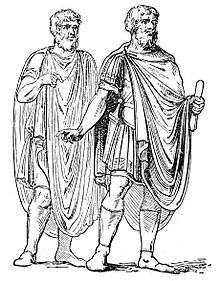Abolla
For the moth genus, see Abolla (moth).

Two men wearing abollas, as seen on the bas-reliefs on the triumphal arch of Septimius Severus at Rome.
An abolla was a cloak-like garment worn by Ancient Greeks and Romans. Nonius Marcellus quotes a passage of Varro to show that it was a garment worn by soldiers (vestis militaris), and thus opposed to the toga.
The abolla was, however, not confined to military occasions, but was also worn in the city.[1] It was especially used by the Stoic philosophers at Rome as the pallium philosophicum, just as the Greek philosophers were accustomed to distinguish themselves by a particular dress.[2] Hence the expression of Juvenal facinus majoris abollae merely signifies, "a crime committed by a very deep philosopher."[3][4][5]
The word abolla is actually a Latinization of the Greek ambolla (ἀμβόλλα) or anabole (ἀναβολή), for a loose woolen cloak.[6]
References
- ↑ Suetonius, Caligula 35
- ↑ Mart. iv. 53, viii. 48
- ↑ Juvenal, iv. 75
- ↑ Heinrich, On Juvenal l.c.
- ↑ Becker, Gallus vol. ii. p. 99
- ↑ Smith, William (1870). "Ambolla". In William Smith. Dictionary of Greek and Roman Antiquities. 1. Boston: Little, Brown and Company. p. 2.
Other sources
- The Wordsworth Dictionary of Phrase and Fable
 This article incorporates text from a publication now in the public domain: Smith, William, ed. (1870). "article name needed". Dictionary of Greek and Roman Antiquities. London: John Murray.
This article incorporates text from a publication now in the public domain: Smith, William, ed. (1870). "article name needed". Dictionary of Greek and Roman Antiquities. London: John Murray.
External links
- Abolla (article in Smith's Dictionary of Greek and Roman Antiquities)
This article is issued from Wikipedia - version of the 8/12/2013. The text is available under the Creative Commons Attribution/Share Alike but additional terms may apply for the media files.